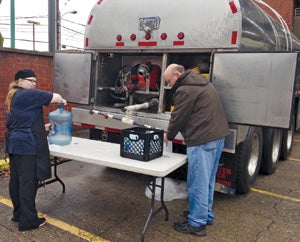Practice makes perfect for system's response to chemical spill
 |
|---|
| Photo by Alan Shearer, Director, CAMC Material Handling Center Staff filled one- and five-gallon containers from a water tanker parked outside CAMC General Hospital for use during the water emergency. |
Between natural disasters and its biannual mock emergency drills, the Charleston (W.Va.) Area Medical Center Health System (CAMC) has had plenty of practice lately in responding to disasters.
All of that experience was put to the test in January when thousands of gallons of 4-methylcyclohexane, a highly toxic chemical used for cleaning coal, spilled from storage tanks into the Elk River, the area's primary water source. More than 30 people were admitted to area hospitals with nausea and vomiting.
When state authorities declared that the chemical posed a potentially serious health risk that rendered the water undrinkable and unusable for medical procedures, CAMC sprang into emergency-response mode, says Glenn Crotty, M.D., chief operating officer.
Emergency challenges are nothing new to CAMC. A derecho — a violent storm with severe winds and heavy rain — knocked out power at CAMC in June 2012. While Hurricane Sandy hammered the Northeast in October that same year, CAMC experienced another power outage accompanied by several inches of snow.
Although dealing with the recent chemical spill was a new test, responding to each of the prior emergencies and the mock drills has served CAMC well.
Like clockwork, administrators immediately set up a command center at General Hospital, the largest of the system's three facilities, and secondary command posts at Memorial Hospital and Women and Children's Hospital.
Staff utilized every communications tool available to keep information flowing among patients, staff, vendors, county and state officials, other area hospitals and anyone who could help to ease the burden during the five-day water ban.
The priorities were to find water to replace the average 7,200 gallons CAMC uses each weekend to care for patients and to determine which clinical services they could still perform. Elective surgeries were canceled for that weekend and trauma cases were diverted to other hospitals, Crotty says.
Within a few hours of contacting the county emergency services department, a 7,000-gallon water tanker was stationed outside General Hospital, says Joe Tucker, system director, housekeeping and logistics. A 1,200-gallon drum filled with water was delivered to one hospital and a 400-gallon drum to another facility, Tucker says.
Local vendors delivered water coolers and ice coolers to the hospitals to ensure that each nursing unit had sufficient water for patients. CAMC also had stored about 24,000 bottles of water on-site for an emergency, Tucker adds.
Eight dialysis stations kept working because another tanker truck was brought in for that unit along with a makeshift piping system that supplied water to the unit from the truck, Crotty says.
Endoscope cleaning continued thanks to a system devised by one of the facilities' staff members. Water was hand-carried from a storage tanker to a 450-gallon drum moved inside the hospital. Water then was pumped to the scope washers using a rigged-up piping system, says Wyatt Roderick, vice president of facilities management, Jones Lang LaSalle, a vendor management partner.
CAMC Teays Valley Hospital, which was not affected by the chemical spill, helped by sterilizing 450 sets of medical instruments before CAMC was cleared to start using its autoclaves again, Crotty says. Another nearby hospital cleaned thousands of pounds of linen.
The bill for purchasing water and other services and equipment plus revenue lost from cancelled surgeries ultimately could total up to $1 million, Crotty says.
He praised the staff's dedication and hard work in getting the health care system through a highly sensitive few days.
Most importantly, of course, no patients were harmed during that time.




